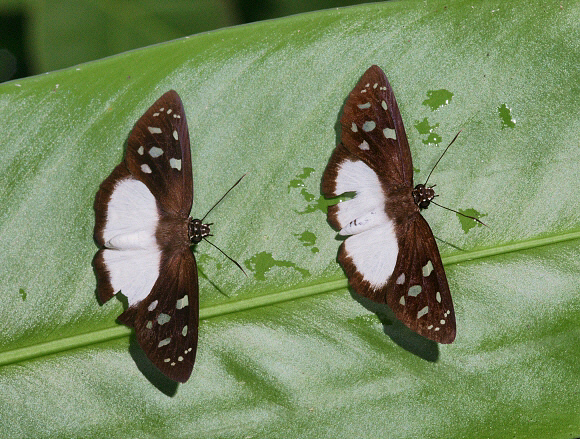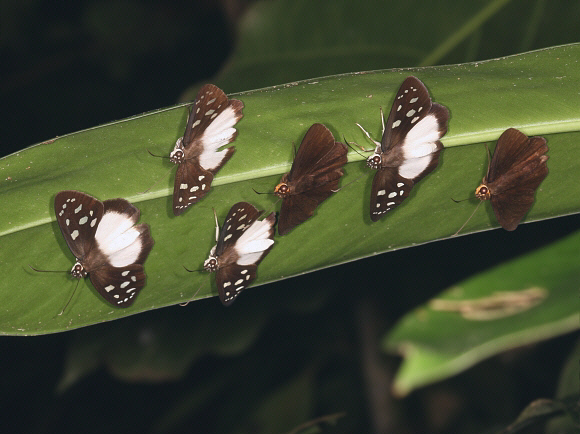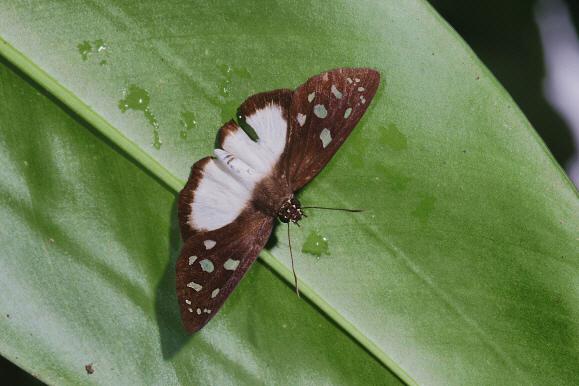
Introduction
The tribe Eudamini includes 44 genera in the neotropical region, amongst which are the Long-tailed Skippers Urbanus, Chioides and Aguna; and such familiar genera as Phocides, Autochton, Astraptes and Calaenorrhinus.
There are 5 known Hyalothyrus species, of which neleus is the commonest and most widespread. It’s vernacular name Social Skipper is given in recognition of it’s habit of gathering in groups beneath leaves :
The 2 Hyalothyrus neleus illustrated above were in a group of 7 discovered resting beneath a large leaf in primary rainforest in southern Peru. As our party of 4 butterfly photographers approached, the entire group burst into flight, whizzing around our heads at high speed for 2 or 3 minutes. They returned one by one over a period of several minutes until eventually 6 of them had resettled under the original leaf. Making a second very cautious approach one of our members was successful in capturing the image below, which depicts 4 females and 2 plain brown males. We each took turns to approach and photograph the butterflies but they were incredibly nervous, and with each approach the numbers returning diminished until only a single female remained.
Quite what was happening under this leaf is a mystery. Was it simply coincidence that a mixed sex group of 7 Hyalothyrus neleus happened to choose to roost under the same leaf? It seems unlikely.
Communal roosting is not a unique phenomenon. The Monarch Danaus plexippus is of course the most well known example – millions of them overwinter together on pine trees in Mexico every year. Other species which roost communally include the Migrant Sulphur Phoebis sennae which commonly settles in groups of 50 or more on bushes in Costa Rica, and the Common Longwing Heliconius erato which I’ve seen roosting in clusters of up to a dozen at sites in Peru, Brazil and Ecuador. In Britain the Silver-studded Blue Plebejus argus often roosts in groups of up to 100 on heather bushes, and in Venezuela I’ve seen as many as 40 Daggerwings Marpesia berania clustered together under the leaves of trees.
The reason why these species gather in groups is unknown. With several million leaves in the vicinity to choose from, why did the Hyalothyrus neleus group settle beneath this particular one ? It seems almost certain that a single butterfly initially settled there, and that pheromones or visual stimuli then attracted the others. It is also very likely that the same group of butterflies use this leaf for several days, and quite possible that successive generations use it for weeks, or even months at a time.
Communal roosting may be a defence strategy – there would be many more pairs of eyes, and more vibration sensors ( found on butterfly legs ) to detect the approach of predators. The sudden scatter-burst of the alarmed butterflies would certainly startle a bird, and then the rapidly swirling mass of skippers, some with white patches, would cause confusion and allow most to escape. A similar strategy is of course used by zebras to evade attacking lions in Africa.

Habitats
This species is restricted to primary rainforest at altitudes between 0-800m.
Lifecycle
The caterpillar feeds on Inga ( Fabaceae ) and is a dirty greenish colour, with a series of prominent pale green spots along the sides, and a large shiny reddish brown head. The internal organs and digestive system are clearly visible through the translucent skin. I have no information about the pupa, but in common with other Pyrgine skippers it is likely to be dark and smooth, with the wing cases in a contrasting tone or colour.
Adult behaviour
Other than the communal roosting described above, the only other observation I have relating to this species is the fact that it is primarily active at dusk, or on overcast days.

